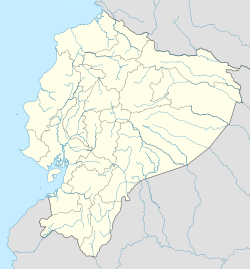Samborondón
This article's tone or style may not reflect the encyclopedic tone used on Wikipedia. (June 2012) |
Samborondón | |
|---|---|
| Samborondón | |
|
| |
Location in Ecuador | |
| Coordinates: 2°11′S 79°53′W / 2.183°S 79.883°W | |
| Country | |
| Province | Guayas |
| Canton | Samborondón Canton |
| Government | |
| • Mayor | Juan José Yúnez |
| Area | |
| • Total | 252 km2 (97 sq mi) |
| Population (2001) | |
| • Total | 11,030 |
| Time zone | UTC-5 (ECT) |
| Climate | Aw |
| Website | http://www.samborondon.gov.ec |
Samborondón is one of the cantons of Guayas province in Ecuador. It has three parishes, two urban parishes, one called La Puntilla and the other called Town of Samborondón (Cabecera cantonal). There's another rural parish called Tarifa. La Puntilla's parish is one of the most exclusive residential and entertainment districts in Ecuador, boasting many Gated Communities (urbanizaciones cerradas) and several retail developments are located in the suburb. Its proximity to the country's second-largest city, Guayaquil (merely crossing a bridge), allows many of its residents to work there. Most of the upper-class families in Guayaquil live at La Puntilla's Parish in Samborondón.
Samborondón was founded on May 24, 1776 and achieve its independence[clarification needed] on October 10, 1820. Since October 31, 1955 the suburb has been a canton. The canton has 105 localities and two urban parishes (La Puntilla) and Samborondón Town (Cabecera cantonal) and one rural parish (Tarifa).[1]
The name Samborondón comes from Saint Brendan, in Spanish San Borondón. The name of the Saint was commonly used in Spain and subsequently in Latin America for towns and villages. The name Samborondón, in general usage, often refers to the rich downtown area of the canton called La Puntilla. In fact, Samborondón consists of a much larger area than just La Puntilla, which is a peninsula between the rivers Babahoyo and Daule (where the River Guayas is formed).
La Puntilla is known as the home of many of the rich and powerful of Guayaquil, including banana tycoon and several-time presidential candidate Álvaro Noboa, Ecuador's richest man. But much the canton is in fact rural and poor, and most of its inhabitants live from the cultivation of rice. Nevertheless, the mayor (who himself lives in Guayaquil) has done a lot to improve their situation and his policies are intended to benefit poorer inhabitants of the canton, as well as the richer inhabitants.[2] Several improvements have been made to the area recently.
Health care
A new branch of the Kennedy Hospital, a local private hospital chain, was finished in 2007 and is now in use.[3] There are also a few building complexes specially built for medical practices.
Shopping and entertainment
The local shopping center, Riocentro Entrerios has many retail stores, a hypermarket, a food court, and a cinema. The Village Plaza was inaugurated in August 2010. A hypermarket from the Supermaxi chain and other 90 stores have been announced. Bocca, La Piazza, La Torre, Las Terrazas, Plaza Lagos, Piazza Villa Club and Plaza Navona are smaller shopping centers, mainly around exclusive restaurants, gyms, night clubs and stores. Tierra Diversión is an amusement park for children aged 2–10 and has a capacity of 100 children. They specialize in children's birthday parties and business events for children. Riverpark is an open-air amusement park for children and young people set with a castle theme.
Tourism
The Parque Histórico, a botanical garden and zoo of the local fauna and flora with reconstructions of historical buildings, is one of the main tourist attractions of Guayaquil.[4]
Samborondón has a hotel boutique, Orilla del Rio, located in Entrerios. Its close proximity to Guayaquil (5 minutes by car, pedestrian access prohibited on the bridge) makes this unproblematic for the visitor, except on peak hours (7–8 a.m. and 4–7 p.m.)
Samborondón is also home to the most exclusive night clubs in Greater Guayaquil and also there are three restaurants-complex with luxurious and innovative cuisine, that otherwise are not found in the city.
Education
Due to the increasing growth of the area, many schools have relocated or established branch campuses from Guayaquil and Quito to Samborondón. Most of them are exclusive private schools, among them Colegio Menor, Abdón Calderón, Torremar and Delta (belonging to Opus Dei), Nuevo Mundo, Liceo Panamericano, Moderna Sergio Pérez Valdez, Centro Educativo Naciones Unidas, La Moderna, CREAR and Monte Tabor. The German School Guayaquil inaugurated a second Kindergarten in Samborondón on April 13, 2009. There are 23 public elementary schools in the Canton.[5]
The first university located in the suburb was the Universidad de Especialidades Espíritu Santo, which opened its doors on 1994.[6] Another university, Ecotec has relocated to the suburb. Since 2000 the ESPOL (Technical University of the littoral) has an annex called PROTCOM in Samborondón, though it only offers 2 courses, leading to a technical associate degree.[7]
Gallery
References
- ^ History
- ^ Two examples from the newspaper El Universo: Mayor promises mending in 8 days and Plan for pedestrian bridge[permanent dead link]
- ^ El Universo Archived 2009-04-15 at the Wayback Machine
- ^ El Universo Archived 2009-09-01 at the Wayback Machine
- ^ Public schools in Samborondón
- ^ "UEES Homepage". Archived from the original on 2009-02-28. Retrieved 2009-02-19.
- ^ "ESPOL". Archived from the original on 2012-02-14. Retrieved 2009-02-21.
External links
- Local government of Samborondón
- University UEES
- [1]
- Article of the Friedrich Ebert Foundation about the impact of the new city concept of security on young wealthy people from Samborondón (Spanish)
- Parque Histórico de Guayaquil (spanish)
- Jose 'Coco' Yunez Campaign page







